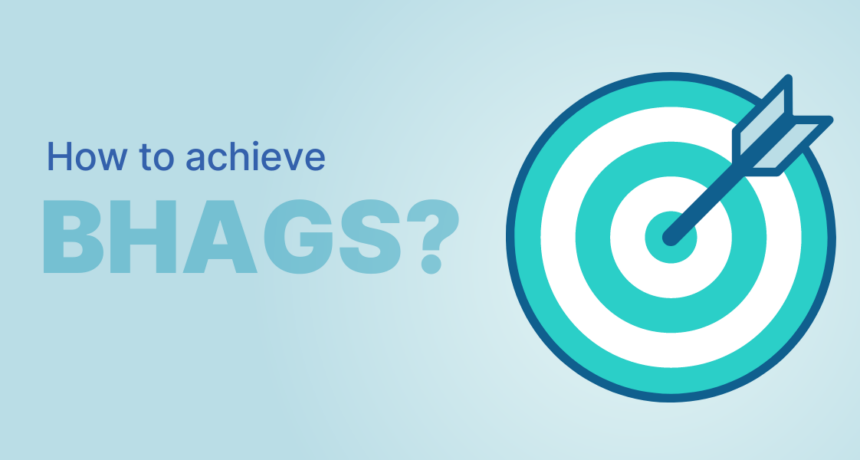Executive Summary
A BHAG (pronounced “bee hag”) stands for Big Hairy Audacious Goal. It’s a simple yet powerful phrase that teams immediately connect with. Consider the following examples:
- Starbucks: Become the most recognized & respected consumer brand in the world
- NASA: Land humans on the moon
- Amazon: Every book, ever printed, in any language, all available in less than 60 seconds (Amazon)
- Microsoft: A computer on every desk in every home (Microsoft)
- Stanford University: Become the Harvard of the west (Stanford University)
Despite the above examples having unique long-term visions, one aspect is consistent: the journey to success was not a straight line.
So, what does this mean for today’s modern product teams?
If a strategy reflects the hypothesis on the best way to achieve a BHAG based on the current state of your product, team, available resources, and market conditions, how do you lead your team to achieve something grand?
In this post, I explain why product leaders must evaluate, align, and adjust their strategies along the journey to achieve their BHAG. I also recommend ways to navigate the constant changes, uncertainty, and constraints you likely face. Let’s get started!
The Need for Portfolio Roadmaps
The former head of product at Asana, Jackie Bavaro, posed a great question on Twitter: How do I create a Product Strategy when all the CEO gives me is a revenue target? You can read the entire thread here, but here’s my favorite part:
A good product strategy has 3 parts: Vision (inspiring picture of the future), Framework (target market and what it takes to win, including pillars, principals, etc.), Roadmap (not a commitment, a wake-up call to see what it takes to achieve the vision in N years)
I’ll summarize the rest, but Jackie explains how a product leader needs to drive the conversations to connect the dots between the business goals and the product work while considering the top customer problems to solve. For each issue, brainstorm ways that solving the problem might achieve the business goal. Which one gets you closer to your BHAG?
Identifying the problem to solve is only the first step. Next, you have to decide how to implement it. How do you have a feature-based roadmap where everyone knows what’s coming and an outcome-based roadmap to illustrate the framework and outcomes?
Feature Roadmap vs. Outcome Roadmaps
Here are a few great examples of hypothetical roadmaps by Gibson Biddle, former head of product at Netflix/Chegg.
Feature Roadmap
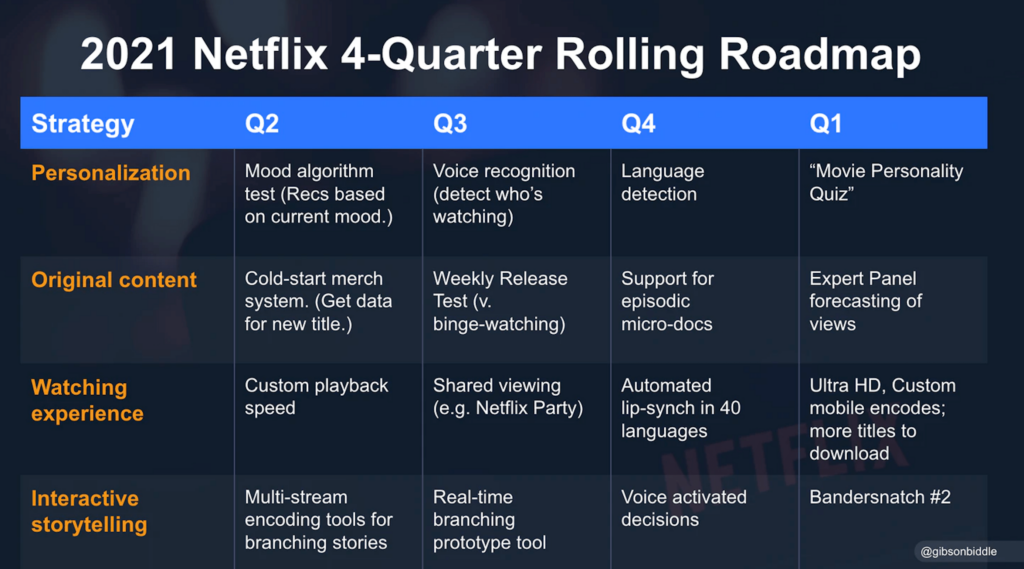
Outcome Roadmap
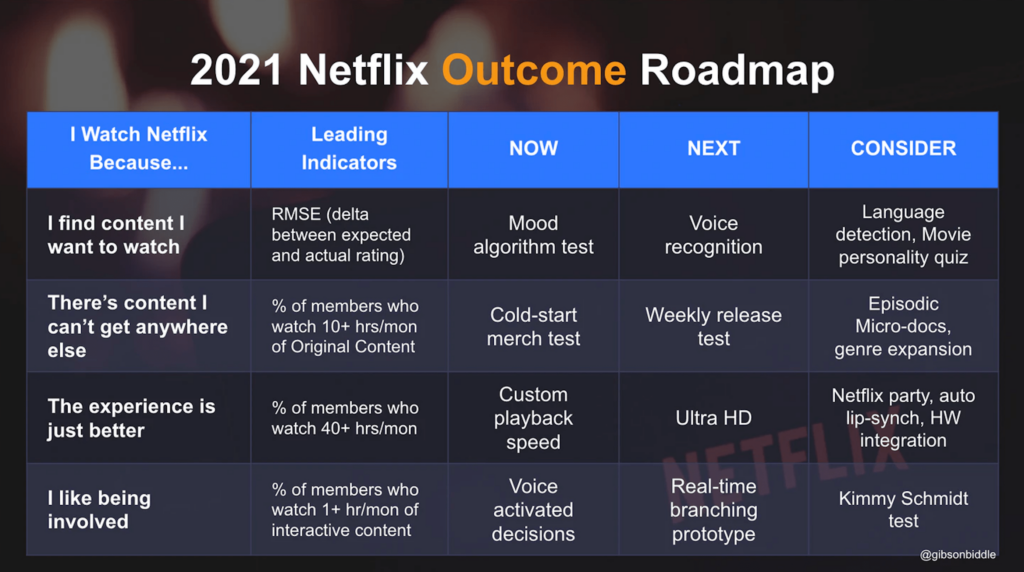
Hopefully, these example roadmaps give you a sense of the critical differences between a feature roadmap and an outcome roadmap. But keep in mind that these are only two examples. A roadmap has even more flavors based on the lens you look through and who your audience is.
Because of the need for multiple roadmaps, companies created multiple slide decks to represent vision, strategy, and BHAG in various ways to illustrate and communicate their plans.
With Dragonboat, you can create and communicate real-time portfolio roadmaps and switch your lens with a few clicks to get a different new perspective—all using the same data. It’s one integrated platform that helps build product roadmaps that accelerate portfolio outcomes.
Our customers call this unique ability “slice and dice” portfolio roadmapping.
Building Outcome-Focused Roadmaps in Dragonboat
If you want to try this framework with your own data, start a free trial and play around! Here is what to do first:
- Consider how your executives talk about strategies, goals, and BHAGs.
- What terms do you use? (swimlanes, value stream, horizon, goals, themes, OKRs)
These are the anchors you will use to organize your portfolio in Dragonboat. They are open-ended by design. Often you may have company or portfolio-wide goals with team-level goals nested underneath. You can use this hierarchy to set up your product portfolio—giving you a dynamic ability to switch “lenses” and quickly view your plans from different perspectives.
Note: If you have multiple independent products with individual goals or themes, send a message to your Dragonboat CSM and ask them to turn on the “portfolio marker” feature, where you may mark whether a goal or theme applies to the entire portfolio or one product area.
Next, let’s talk about the timeframes.
- Do you use a quarterly horizon for the next 4 quarters?
- Or do you take a “lean roadmap” approach with Now/Next/ Later?
Having both is also okay!
Here is a template of Rolling Quarterly Roadmap based on the Netflix example above.

Here is a template for fuzzy timeframes like Now Next or Later based on the Outcome Roadmap Template of the Netflix example.
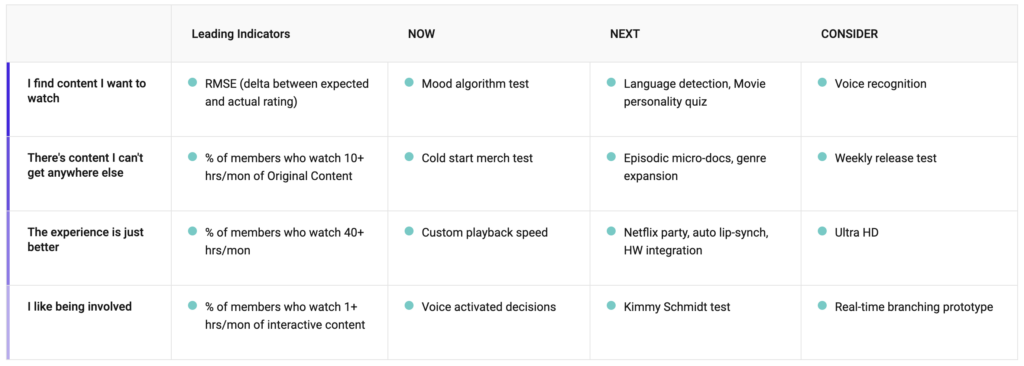
With timeframes established, you’ll want to focus on your next level of leaders: Directors and Managers.
How can they translate the goals, strategies, or outcomes to their day-to-day work? The work is often referred to as features, initiatives, or bets, and they:
- Map to specific goals and strategies
- Defined with a high-level scope and duration
- Contain an owner who is responsible for driving the work forward
A feature represents an Epic that’s typically done by a team in a few sprints. And an initiative typically represents a basket of features that have a tangible impact on specific outcomes. Initiatives involve multiple teams and last for a quarter or more.
In larger organizations, you may have strategic bets that last half a year or longer with significant resources devoted across many teams.
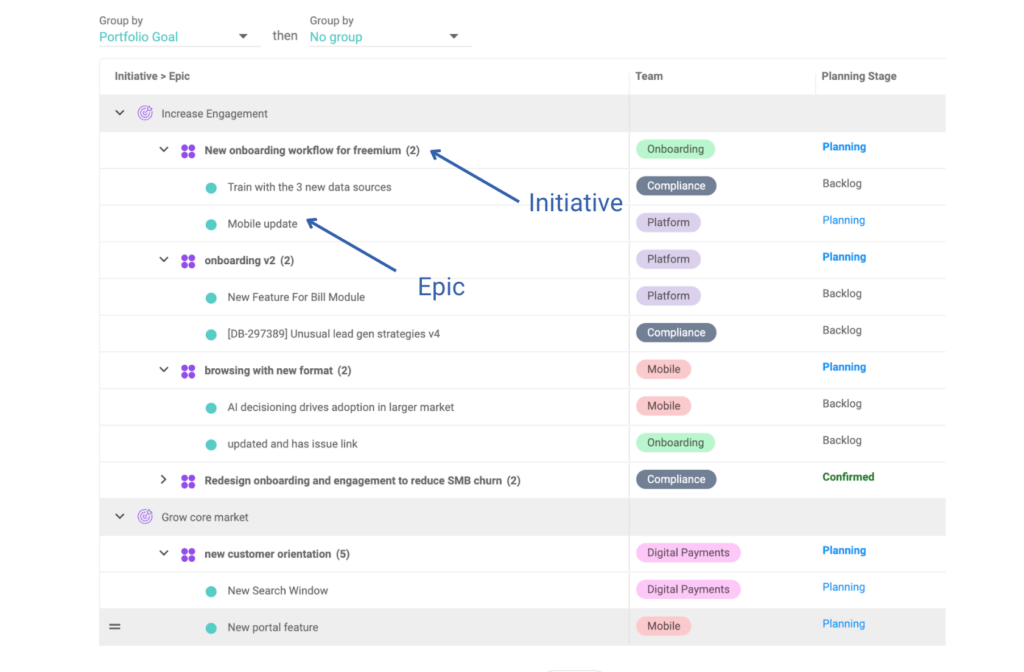
Another element for consideration is how your product team is structured. Some teams call these different lenses Roadmap and Sub-Roadmap. Others call it Product Group and Product. At the same time, others may have Pods and Squads.
No matter what you call it, you can define your portfolio through the lens that makes the most sense to your product team while giving everyone a space to focus and coordinate their plans.
Conclusion
As no product is built by a single team, having a source of truth with a consistent and holistic view enables effective communication, planning, executing, and ultimately, achieving your BHAG!
Dragonboat supports high-level strategic planning but gives you the flexibility in timeframe and team-specific planning to make things work for all teams. And it does it all in one product roadmapping and portfolio management platform.
